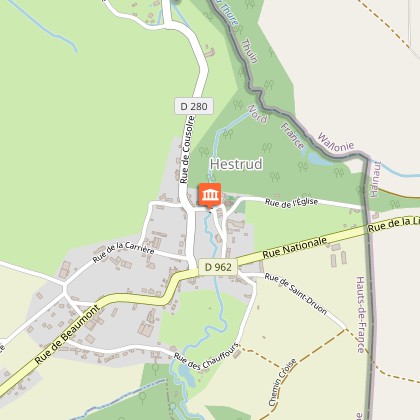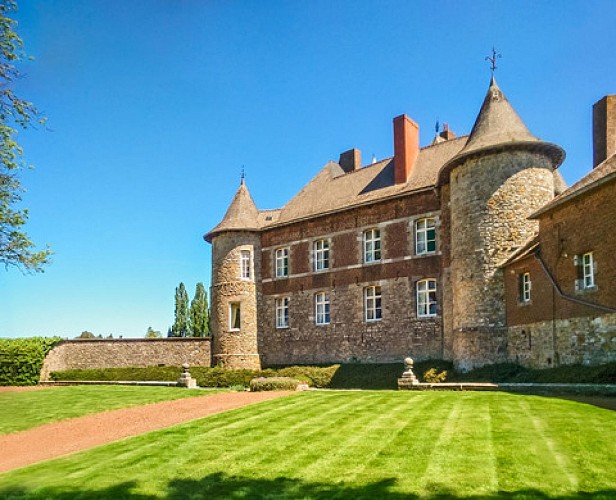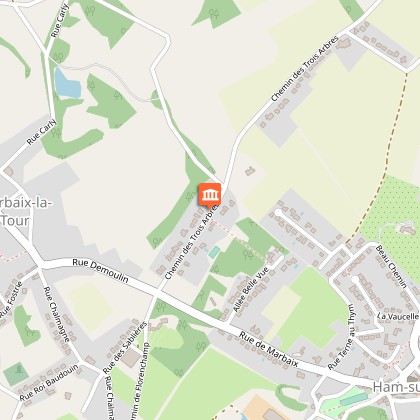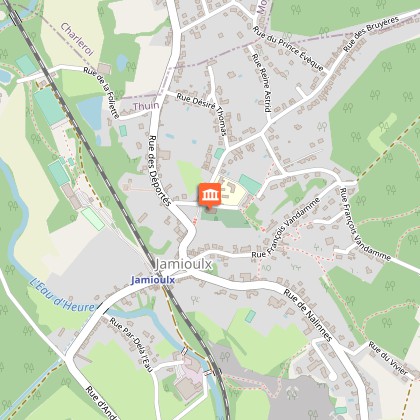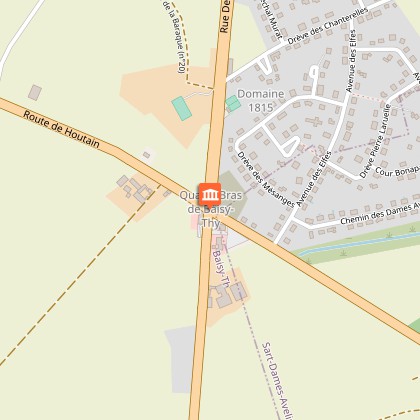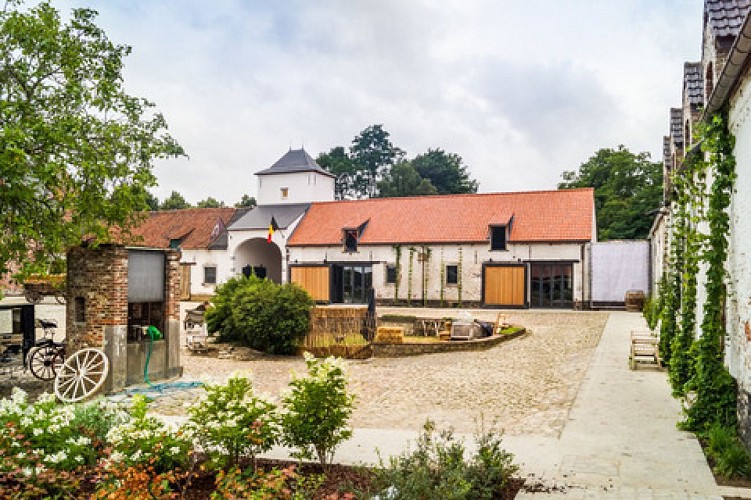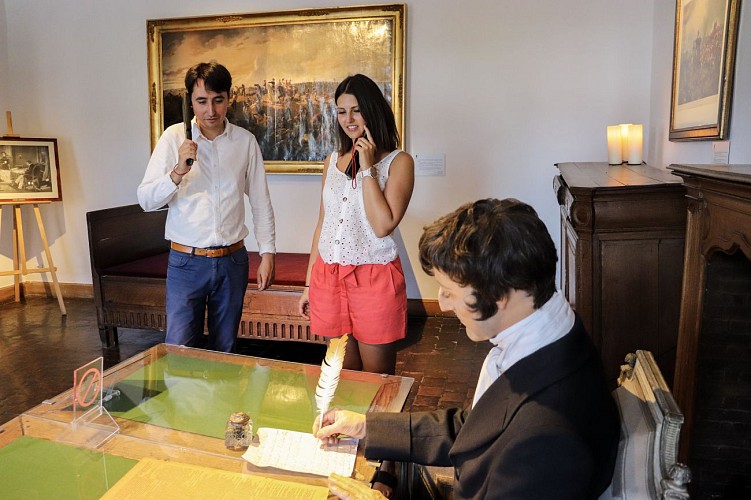Allarme
Allarmi
Tipo di pratica
In auto
Presentazione
Mappa
Punti di interesse
Sintesi di Cirkwi
Valutazioni e recensioni
Vedi nei dintorni
La Route Napoléon en Wallonie

Il breve di Cirkwi
Esplora l'ultimo viaggio di Napoleone attraverso la Vallonia
Imbarcati in un affascinante viaggio lungo la Route Napoléon in Vallonia, tracciando la storica marcia dell'Imperatore Napoleone prima della fatidica Battaglia di Waterloo nel 1815. Curata da VISITWallonia, questo viaggio di 94 chilometri si addentra in una ricca trama di storia, musei, siti patrimonio dell'UNESCO, panorami mozzafiato e deliziosa gastronomia locale. Il tuo viaggio nel tempo è sottolineato da pannelli informativi che ti guidano attraverso soste significative, come Hestrud, dove un coraggioso giovane villaggio ha famosamente affrontato Napoleone. Immergiti in un'atmosfera che ripercorre la grandezza e la solennità di un'epoca cruciale nella storia europea.
Panoramica tecnica dell'itinerario
La Route Napoléon in Vallonia si estende per 115,098 chilometri, con l'altitudine massima che raggiunge i 234 metri e il minimo a 99 metri. L'itinerario presenta un cambiamento di altitudine positivo tra i 698 e i 760 metri, rappresentando una guida moderatamente impegnativa. Adatto alle auto, questo viaggio espansivo promette non solo un arricchimento storico ma anche un'esperienza di guida coinvolgente attraverso altitudini variabili e viste panoramiche mozzafiato. Questa diversità tecnica aggiunge un elemento di avventura nel scoprire il passato.
Consigli di viaggio stagionali
Indipendentemente dalla stagione, la Route Napoléon offre esperienze uniche. In primavera ed estate, i paesaggi rigogliosi e il clima più caldo offrono condizioni ideali per esplorazioni tranquille e pic-nic nei siti storici. Tuttavia, porta sempre acqua e indossa la crema solare. L'autunno trasforma l'itinerario con magnifici colori, offrendo un'immagine pittoresca; fai attenzione alle strade scivolose però. L'inverno richiede una preparazione attenta; assicurati che il tuo veicolo sia pronto per l'inverno e controlla le previsioni meteo per la neve, che può aggiungere una bellezza serena ai siti ma potrebbe influire sui piani di viaggio.
Significato storico di Hestrud
Hestrud, il punto di partenza di questo viaggio, è più di un semplice villaggio pittoresco in Vallonia. Il suo ruolo come porta d'ingresso per l'entrata di Napoleone nell'attuale territorio vallone è di monumentale importanza storica. L'incontro tra Napoleone e un audace giovane villaggio qui aggiunge uno strato personale alla grande trama della storia europea, mettendo in evidenza il ruolo cruciale del villaggio nei giorni precedenti alla Battaglia di Waterloo. Questo evento testimonia il ricco patrimonio storico che la Vallonia preserva, rendendola un tesoro per gli appassionati di storia.
Informazioni sul clima per la Vallonia
Il clima in Vallonia solitamente presenta temperature miti o fresche, con stagioni distinte che offrono esperienze varie per i viaggiatori. Gli inverni possono essere freddi e talvolta nevosi, rendendolo un momento magico per gli appassionati di storia che non si preoccupano del freddo. La primavera vede la regione sbocciare in colori vibranti, mentre l'estate è generalmente mite e piacevole, perfetta per le attività all'aperto. L'autunno porta un'atmosfera fresca e i bellissimi colori dell'autunno. Per un percorso ottimale lungo l'itinerario di Napoleone, si consiglia la fine della primavera fino all'inizio dell'autunno, bilanciando il buon tempo con l'atmosfera storica della regione.
Imbarcati in un affascinante viaggio lungo la Route Napoléon in Vallonia, tracciando la storica marcia dell'Imperatore Napoleone prima della fatidica Battaglia di Waterloo nel 1815. Curata da VISITWallonia, questo viaggio di 94 chilometri si addentra in una ricca trama di storia, musei, siti patrimonio dell'UNESCO, panorami mozzafiato e deliziosa gastronomia locale. Il tuo viaggio nel tempo è sottolineato da pannelli informativi che ti guidano attraverso soste significative, come Hestrud, dove un coraggioso giovane villaggio ha famosamente affrontato Napoleone. Immergiti in un'atmosfera che ripercorre la grandezza e la solennità di un'epoca cruciale nella storia europea.
Panoramica tecnica dell'itinerario
La Route Napoléon in Vallonia si estende per 115,098 chilometri, con l'altitudine massima che raggiunge i 234 metri e il minimo a 99 metri. L'itinerario presenta un cambiamento di altitudine positivo tra i 698 e i 760 metri, rappresentando una guida moderatamente impegnativa. Adatto alle auto, questo viaggio espansivo promette non solo un arricchimento storico ma anche un'esperienza di guida coinvolgente attraverso altitudini variabili e viste panoramiche mozzafiato. Questa diversità tecnica aggiunge un elemento di avventura nel scoprire il passato.
Consigli di viaggio stagionali
Indipendentemente dalla stagione, la Route Napoléon offre esperienze uniche. In primavera ed estate, i paesaggi rigogliosi e il clima più caldo offrono condizioni ideali per esplorazioni tranquille e pic-nic nei siti storici. Tuttavia, porta sempre acqua e indossa la crema solare. L'autunno trasforma l'itinerario con magnifici colori, offrendo un'immagine pittoresca; fai attenzione alle strade scivolose però. L'inverno richiede una preparazione attenta; assicurati che il tuo veicolo sia pronto per l'inverno e controlla le previsioni meteo per la neve, che può aggiungere una bellezza serena ai siti ma potrebbe influire sui piani di viaggio.
Significato storico di Hestrud
Hestrud, il punto di partenza di questo viaggio, è più di un semplice villaggio pittoresco in Vallonia. Il suo ruolo come porta d'ingresso per l'entrata di Napoleone nell'attuale territorio vallone è di monumentale importanza storica. L'incontro tra Napoleone e un audace giovane villaggio qui aggiunge uno strato personale alla grande trama della storia europea, mettendo in evidenza il ruolo cruciale del villaggio nei giorni precedenti alla Battaglia di Waterloo. Questo evento testimonia il ricco patrimonio storico che la Vallonia preserva, rendendola un tesoro per gli appassionati di storia.
Informazioni sul clima per la Vallonia
Il clima in Vallonia solitamente presenta temperature miti o fresche, con stagioni distinte che offrono esperienze varie per i viaggiatori. Gli inverni possono essere freddi e talvolta nevosi, rendendolo un momento magico per gli appassionati di storia che non si preoccupano del freddo. La primavera vede la regione sbocciare in colori vibranti, mentre l'estate è generalmente mite e piacevole, perfetta per le attività all'aperto. L'autunno porta un'atmosfera fresca e i bellissimi colori dell'autunno. Per un percorso ottimale lungo l'itinerario di Napoleone, si consiglia la fine della primavera fino all'inizio dell'autunno, bilanciando il buon tempo con l'atmosfera storica della regione.
Generato automaticamente.
IGN Carte

2806SB - MAUBEUGE JEUMONT
Editore : IGN
Collezione : TOP 25 ET SÉRIE BLEUE
Scala : 1:25 000
13.90€

102 LILLE MAUBEUGE PNR SCARPE ESCAUT PNR DE L'AVESNOIS
Editore : IGN
Collezione : TOP 100
Scala : 1:100 000
8.40€

D59-62 NORD PAS-DE-CALAIS
Editore : IGN
Collezione : CARTES DÉPARTEMENTALES IGN
Scala : 1:150 000
5.90€

NR05 GRAND EST RECTO/VERSO MASSIF DES VOSGES ALSACE LORRAINE
Editore : IGN
Collezione : CARTES RÉGIONALES IGN
Scala : 1:250 000
6.80€

NR04 - GRAND EST RECTO/VERSO ARDENNE CHAMPAGNE
Editore : IGN
Collezione : CARTES RÉGIONALES IGN
Scala : 1:250 000
6.80€

NR01 HAUTS-DE-FRANCE
Editore : IGN
Collezione : CARTES RÉGIONALES IGN
Scala : 1:250 000
6.80€

EUROPE
Editore : IGN
Collezione : DÉCOUVERTE DES PAYS DU MONDE IGN
Scala : 1:2 500 000
7.00€

PAYS-BAS BELGIQUE LUXEMBOURG
Editore : IGN
Collezione : DÉCOUVERTE DES PAYS DU MONDE IGN
Scala : 1:300 000
7.00€
Informazioni tecniche
In auto
Difficoltà
Non specificata
Dist.
115 km
Tipo di pratica
In auto
Mostra di più
Profilo altimetrico
Punto di partenza
823
Rue de Beaumont
,
59740
Hestrud
Lat : 50.1991Lng : 4.15222
Punti di interesse
Autore dei dati

proposto da
VISITWallonia
Avenue Comte de Smet de Nayer 14 5000 Namur Belgique
Valutazioni e recensioni
Da vedere nei dintorni
